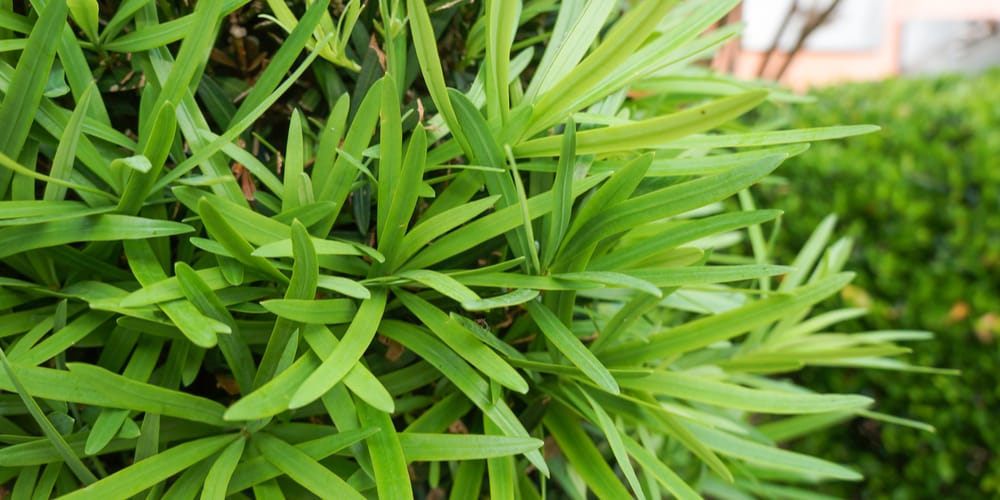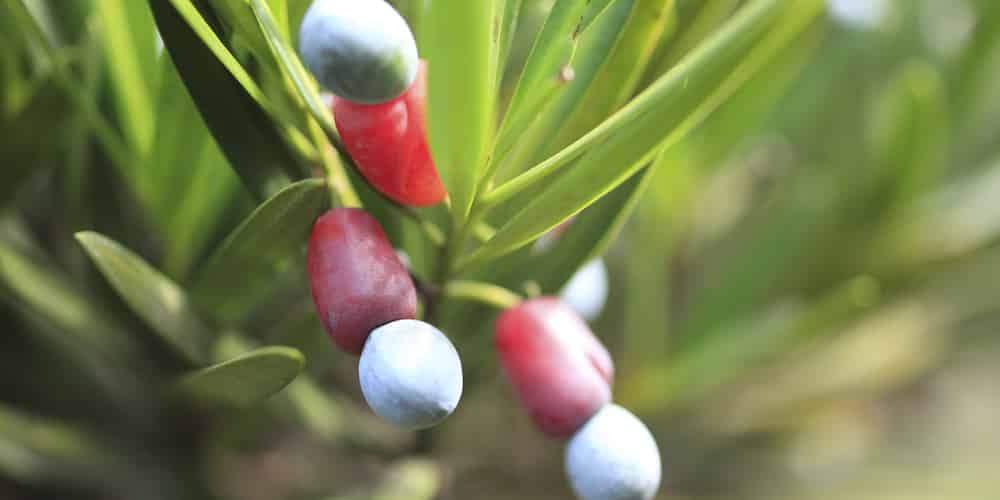Podocarpus maki is a slow-growing, compact and dense variety of the podocarpus species, with dark green leaves that look like needles. Let’s look at Podocarpus Maki care requirements to help you grow a thriving plant.

| Botanical Name | Podocarpus macrophyllus ‘Maki’ |
| Common Name | Shrubby Podocarpus, Chinese Podocarpus |
| Plant Type | Perennial |
| Flower Color | None |
| Size When Mature | 120 to 180 inches |
| Bloom Time | None |
| Sun Requirements | Full Sun, Part Shade |
| USDA Hardiness Zones | 7 to 11 |
| Soil PH Range | 4.5 to 7.5 |
| Soil Type | Acidic, well-drained |
| Water Needs | Medium |
| Native Area | Japan, Southern China |
What you Need to Know About The Podocarpus Maki
Podocorpus Macrophyllus ‘Maki’ is a low-maintenance, evergreen shrub with deep green and thin leaves. Otherwise known as Yew Pine or Japanese Maki, the plant makes for a good hedge, privacy screen, and in containers.
Chinese podocarpus is a slow grower and best used to fill in narrow spaces. Being an evergreen, you can count on the podocarpus variety to provide season-long interest in any space. It’s worth noting that the plant is toxic to pets and humans. That said, you may want to think twice before placing your podocarpus plants indoors or within easy reach.
Podocarpus Maki Care
Here’s everything you need to know about growing and caring for a thriving Podocarpus Macrophyllus ‘Maki’
Light
Podocarpus shrubs tend to be adaptable when it comes to light requirements. In its preferred growing zones, the Japanese Yew ‘Maki’ accepts any site that gets full sun to part shade, or even full shade as long as it gets bright natural light all day.
Interestingly enough, the dwarf cultivar can be grown as a houseplant year-round in a window that gets direct sun. Growth won’t be affected if kept in a suitably-sized container, and you’ll be able to overwinter the podocarpus to protect the plant from extreme cold. Chinese podocarpus grows slowly and can be maintained to stay at around 4 to 6 feet (or 48 to 72 inches).
Water and Soil Needs
Though generally easy-going on sunlight requirements, the podocarpus ‘Maki’ will need slightly acidic soil or else it will develop chlorosis. More than that, you will need to provide an organically rich and well-drained medium as the shrub doesn’t like sitting on wet soil for too long.
As far as soil type is concerned, you can use any material as long as it drains well. The shrub can take loam, sand, and clay soil and is salt-tolerant to a degree. Watering will largely depend on the climate and the soil- if it’s heavy, you should allow the top surface to dry out first before reaching for the watering can.
Temperature Requirements
Shrubby podocarpus ‘Maki’ is rated hardy in zones 7 through 11, which means it can take warm and sunny environments in stride. You may need to protect with a light cover during winter frosts. Podocarpus can tolerate up to 10 degrees F before its leaves and stems get damaged.
Fertilizer
The best fertilizer to use on a Podocarpus Maki is a balanced fertilizer given three times per growing season.
You can feed your Japanese Yew ‘Maki’ a balanced NPK solution of 6-6-6 at the recommended instructions listed on the label. Fertilizing dosage will largely depend on the shrub’s size- a trunk that’s less than 6 inches may require up to three pounds of the said fertilizer compound. Space the application 3 times, or opt for a slow-release formula so you can feed only once.
It’s recommended that you don’t fertilize when the plant is dormant as it could affect its growth rate and health. Proper feeding at the right time encourages a flush of growth and helps the plant stay strong and healthy.
Common Diseases
The Podocarpus ‘Maki’ is a tough evergreen shrub, able to live in most urban conditions. The plant can thrive in poor soil and is deer-resistant as well. Shrubby podocarpus does not have any serious disease and pest problems, but it can be affected by scale and chlorosis in certain scenarios.
When podocarpus leaves turn yellow it’s usually a sign of chlorosis, which means the soil isn’t acidic enough for their tastes. When this happens, you should amend the soil with acid-raising components or feed a liquid fertilizer that can alter the pH.
Scale may appear from time to time and may be treated with insecticidal soap or by spraying with neem oil. Also, be careful when watering your podocarpus ‘Maki’ as too much can lead to fungal diseases and root rot.
Podocarpus Maki Propagation
Propagating a Chinese Podocarpus may take time but it’s definitely doable. The evergreen can be propagated using a softwood cutting and putting it in a constantly moist medium until the cutting takes root.
The best time to take a softwood cutting for podocarpus is in late spring or early summer. Take anywhere between 3-5 inch cuttings and on flexible podocarpus branch tips. Then, strip off all the lower leaves until you reach the top. The two leaves at the top should stay so they can concentrate on forming roots.
At this point, you should prepare the medium for the cutting. You can root podocarpus maki in water or a sandy medium.
Place the cutting in a glass of water and remember to change the water every two to three days. For sand or loamy medium, keep spraying every day until you see signs of new growth.
